Grimsey Island lies 25-miles north of mainland Iceland in the cold but bountiful Arctic Ocean. It is famous for its large colonies of seabirds including Auks and Puffins, for its chess players, the church built from drift wood, for the Arctic Circle divide line cutting the through the northern half, and for being the furthest north of Iceland’s inhabited islands. What is not known is the quality of its shore cod fishing!
I’d been in Dalvik on the mainland a couple of years previously fishing with Steve Mason, owner of Iceland Fishing Adventures, and we’d pondered the possibility then of getting out to Grimsey, but time and work commitments meant we had to let the chance pass. The thought never left us and the intention was to get there as soon as possible.
It was two years later when Steve, Northeast angler Joe MacDonald, my fishing buddy Colin Albert from Cardiff and I boarded the Dalvik ferry to Grimsey with a car loaded down with gear with the intention of checking out the island over a short two day stay.
The island has sheer cliffs on the north side, but accessible rock ledges and boulder beaches on the south side. The ground is generally mixed rough and fine sand with kelp weed beds in close. To say it looks good for cod is very much an understatement!
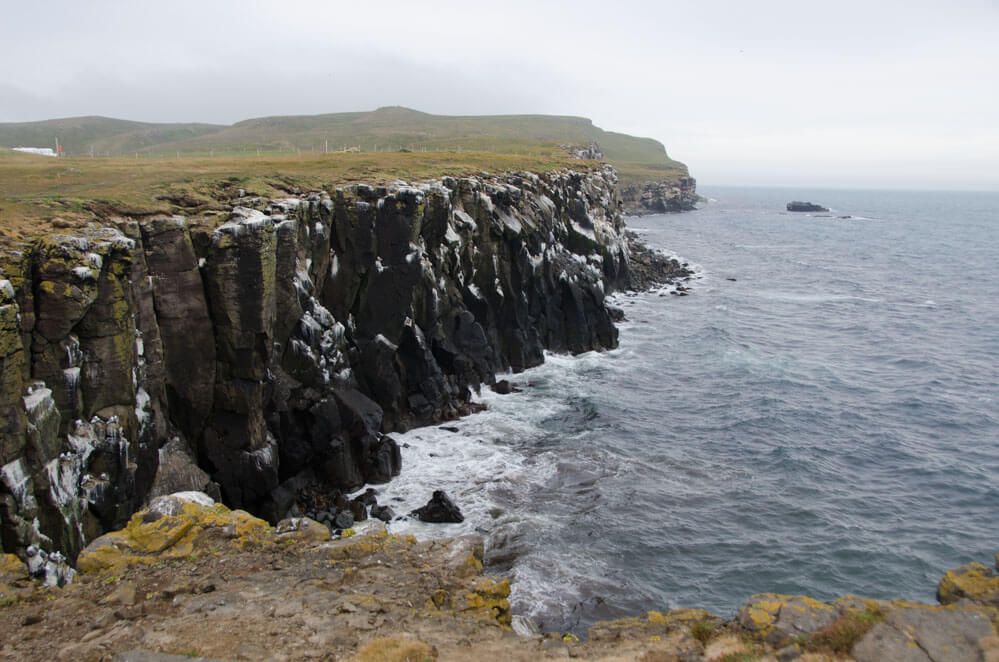
We walked part of the coast in the north section and saw sandy ground with outcrops of kelp and rock pretty much as far as the eye could see in the gin clear water. Because of the water clarity we opted for a mark on the southern end close to an old wind turbine and found easy access on to a rock ledge in to moderately deep water, again with mixed clean and rough patches.
We had fresh lugworm dug on the mainland by Steve, fresh mussel, and the ever reliable bluey. We each chose our own combo and fired the baits out.
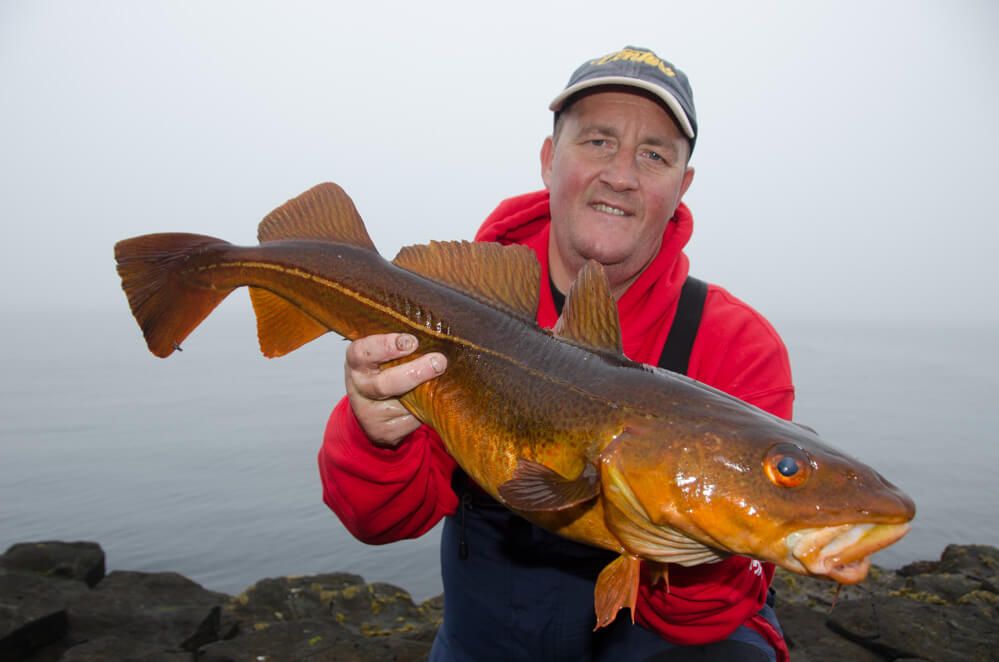
I could write this feature detailing our fish by fish catch, but it would be a feature of biblical proportions. No sooner had our baits hit the water, the rod tops were nodding. It was cod after cod ranging between 3 and maybe 8lbs. These were beautifully coloured rock cod, some orange, some a red or vermillion, others a golden brown to camouflage the cod in amongst the weed.
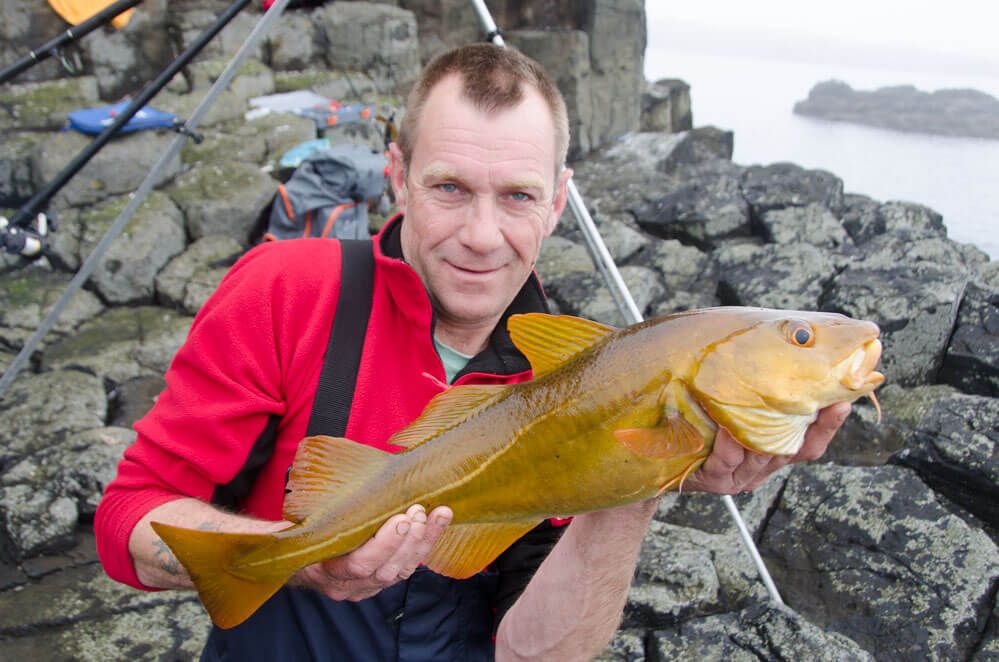
I was trying to keep pace with the camera as fish were being continually landed, at the same time conscious of my rod being dragged in to the sea by a hungry cod. This was on an ebbing tide and towards low water the bites eased, but did not disappear. But it was late afternoon and time to get something to eat. How many cod did we catch? I have no idea, we each had between 15 and 20 cod, so that’s around 75 cod for just four hours or so fishing.
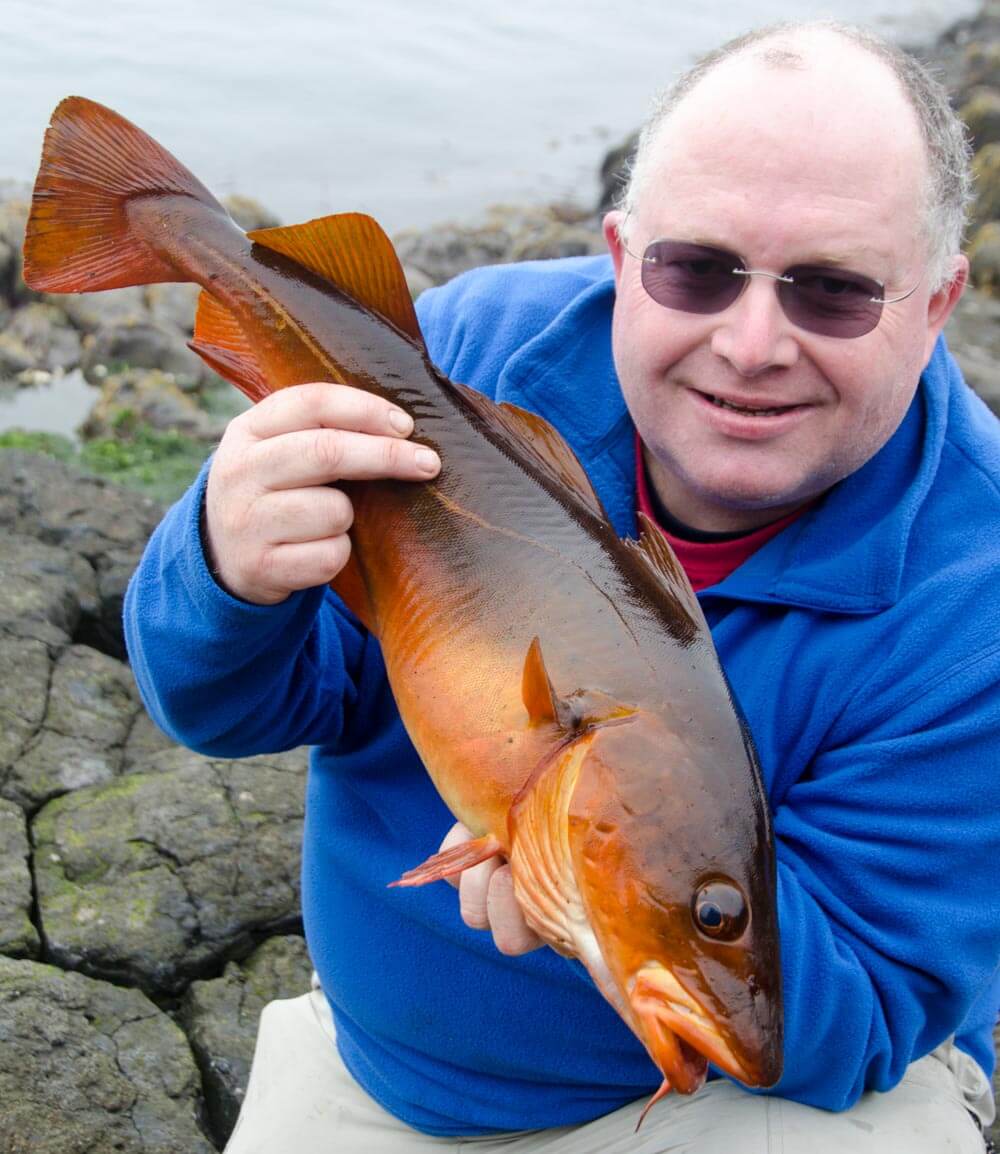
The commercial harbour is flanked by a protective breakwater with casting access left and right of the marker post to a deeper ship channel. The depth here falls in to about 30-feet 40-yards out, but gets deeper if you put a long cast in. This was another mark we fished with the baits.
Nobody bothered to cast too far, 50-yard lobs were ample, just putting the bait in the middle of the channel. As before, as soon as the baits hit the bottom the rod tips were nodding to self-hooked cod. These were nice fish averaging 5lbs that just kept coming one after the other.
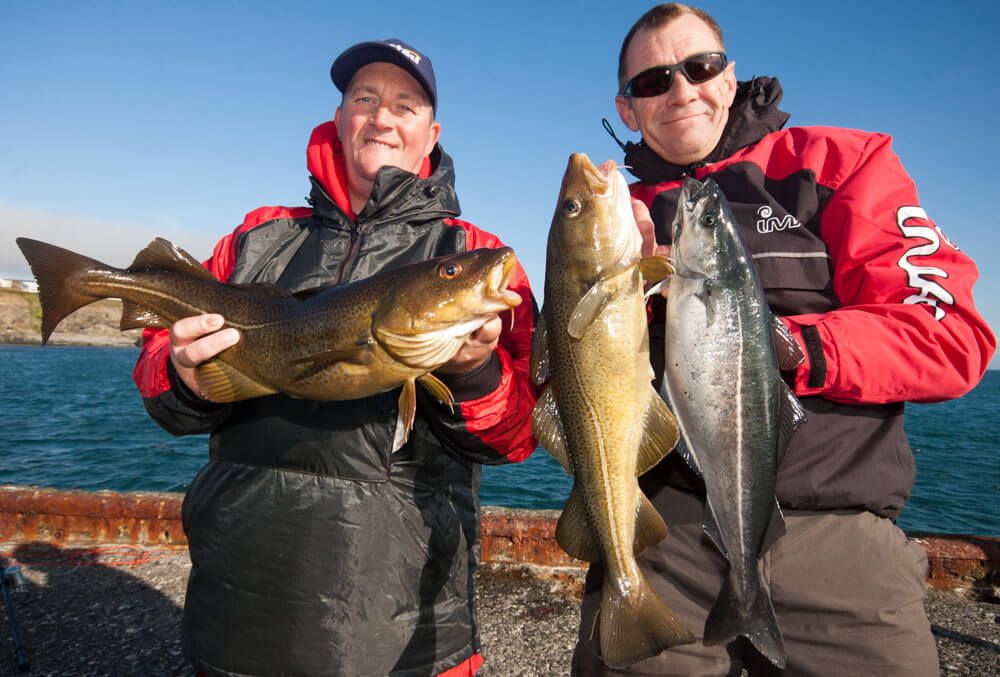
Coalfish were in amongst the cod. Colin and I were on the far end of the breakwater banging baits on to rougher ground. I was playing out a cod about 6lbs, when Colin briefly hooked a coalie before the hook pulled out. Suddenly, as the released bait fell in the water, the rod stopped dead and a heavy weight slammed the rod hard over. This fish just pressured the rod for the first few seconds confused as to what was happening, then bored off seaward, turned, ran in towards the breakwater and shot back out again dragging an alarming amount of line off the reel.
Having fished with Col for nigh on 30-years, I’ve seen him battle a good fish or two, and he’s not prone to surprise or panic, but I could see the shock in his face as to how hard this fish was pulling. He also felt the pressure of fishing for the camera and played the fish carefully. After a good 5-minute fight a silver blue shape materialised near the surface tight in to the jetty. We all saw the size of the beast, but little was said, it wasn’t caught yet. It made one more worrying crash dive for the seabed, but this sapped its energy and it was steered in to the waiting drop net. It weighed 18lbs and is indicative of what this unexplored area could produce once fully explored.
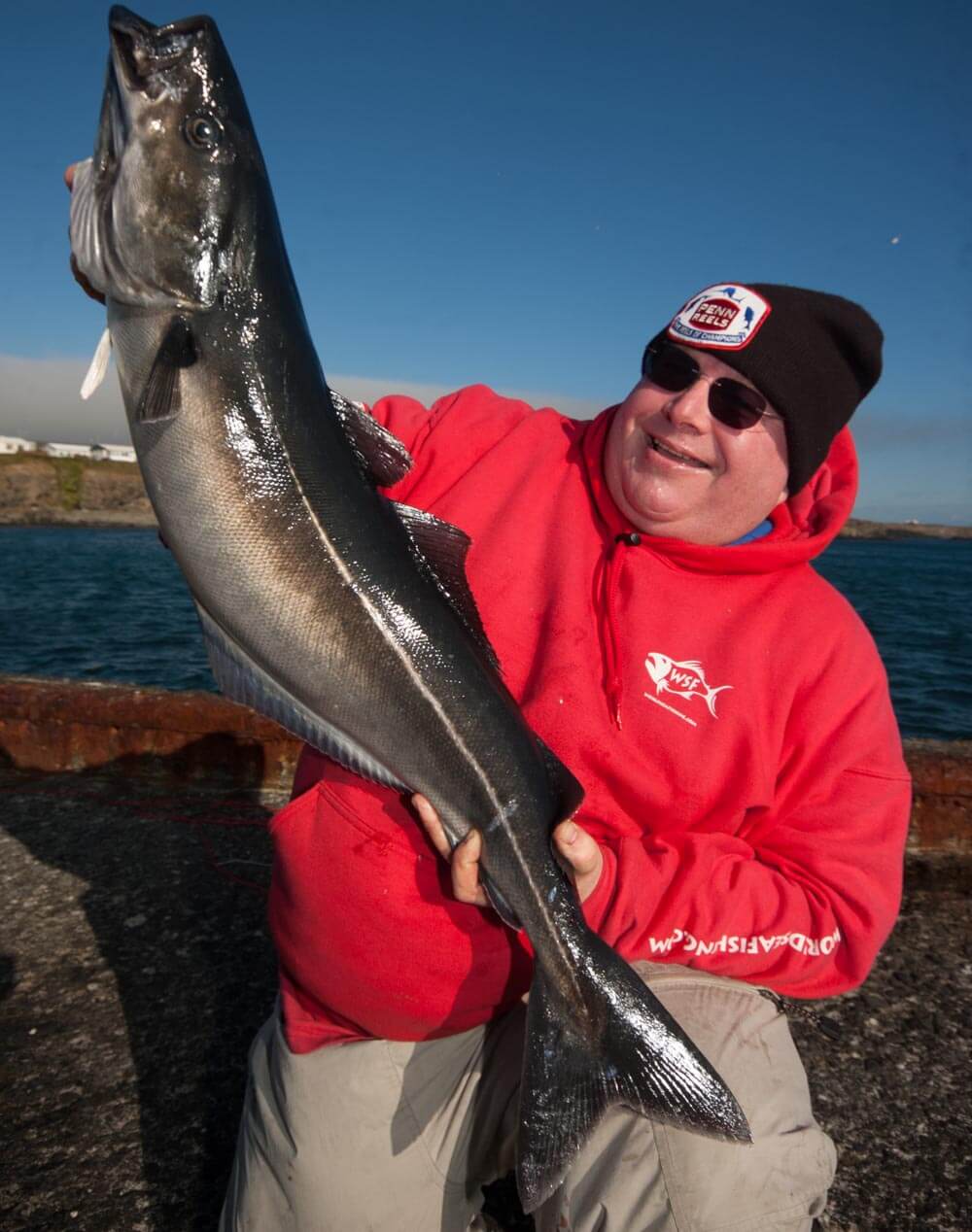
It was late evening now and the fishing just got better with bigger cod coming out to play. There were still the 5lbers, but mixed in evenly now with fish in the 7lb to 10lb range. Fat, healthy fish with a pop belly and weight behind their head, plus a broad paddled tail. Again, how many fish? Somewhere between 150 and 200 at a guess. How can you tell when its one after the other with no let up?
The lads went on to spinners and even float fished baits and still caught at the same rate. I went fly fishing and hooked a cod or a coalie each and every cast. The numbers of fish in front of us was nothing short of incredible.
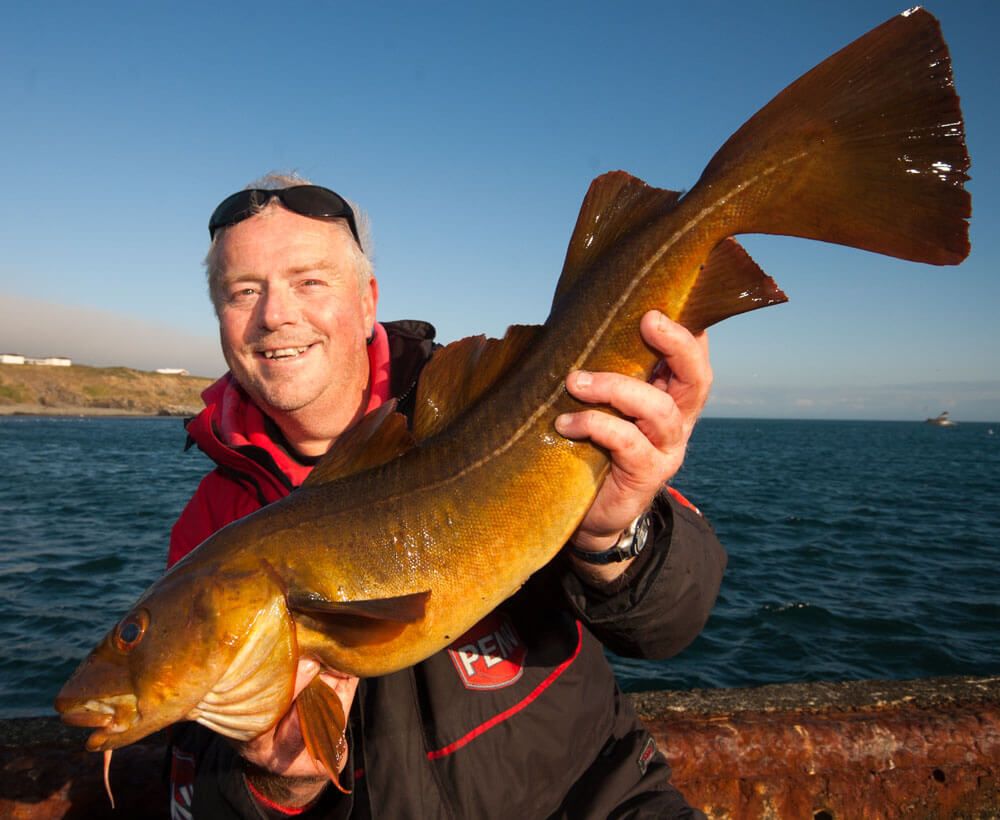
We were due back on the ferry the next day, so had a short session on the breakwater to finish with exactly the same result, cod, cod, coalie, cod, cod, cod, coalie and so on.
Did we expect a few bigger fish? Yes, we did. But with hindsight, we fished it in August with little in the way of a dark night and with just the two days on the island a full night session was impossible. When, not if, I go back, then I’ll look to fish a dark tide and will expect to see bigger fish. I’d also consider going earlier or later in the year, say May/June or September when I think bigger fish may be more likely. This is just a personal opinion, but I’d like to try it!
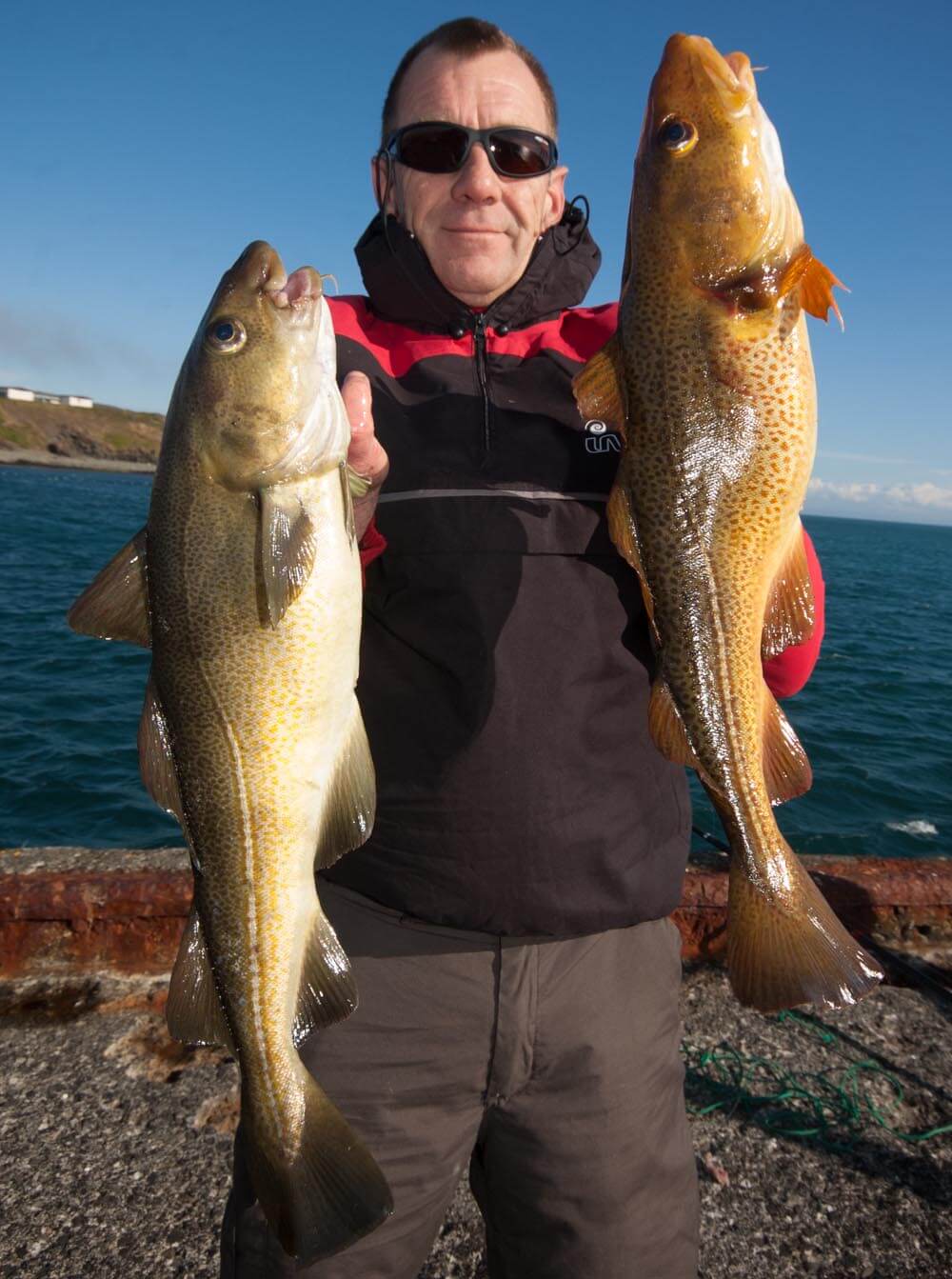
TACKLE TO TAKE
The ground is not difficult to fish, also you don’t need to cast to range as it makes no difference to the catch rate. Steve provides top quality and powerful Century blanks which we used and are perfect for the job. However you take your own reels and I chose to fish a Penn 525Mag2 loaded with 22lb line. Apart from snagging up a few times when fishing the rock ledge towards low water by casting a long way, the 22lb line was more than enough. Take two reels, just in case you have a problem with the other, but it’s unlikely you’ll be fishing two rods as you just will not cope with the catch rate. There’s too many fish!
Steve also provides the lead weights and rod rests. All you need then is a box of general rig bits, spare shock leader, spare hooks, a honing stone, scissors, bait elastic and some pliers. Take a couple of spools of spare reel line too, in case of birdies or snap offs.
Regarding shock leader, due to the clarity of the water I would suggest only using clear mono. Yes the fish are fighting to get at your bait, but bigger fish are not so stupid and a clear mono makes logical sense, so why risk it?
RIGS
Both Colin and I built about 20 pulley rigs to take with us and brought most home. I made mine as follows and wouldn’t change the design…
Although we had lugworm, also the odd clam with us, which all work well, the bulk of the fish came to bluey. I know it’s hard with a UK cod/lugworm mentality to think of cod taking fish baits, but you have trust these words, the Icelandic cod love bluey and it fishes better than worm in my experience.
I just stick to bluey baits, either using the cone section from the tail with the tail fin cut off, or a straight body section anything from 3-inches long to a full body with just the head and tail taken off. Alternatively a body section with one fillet removed to leak plenty of scent out.
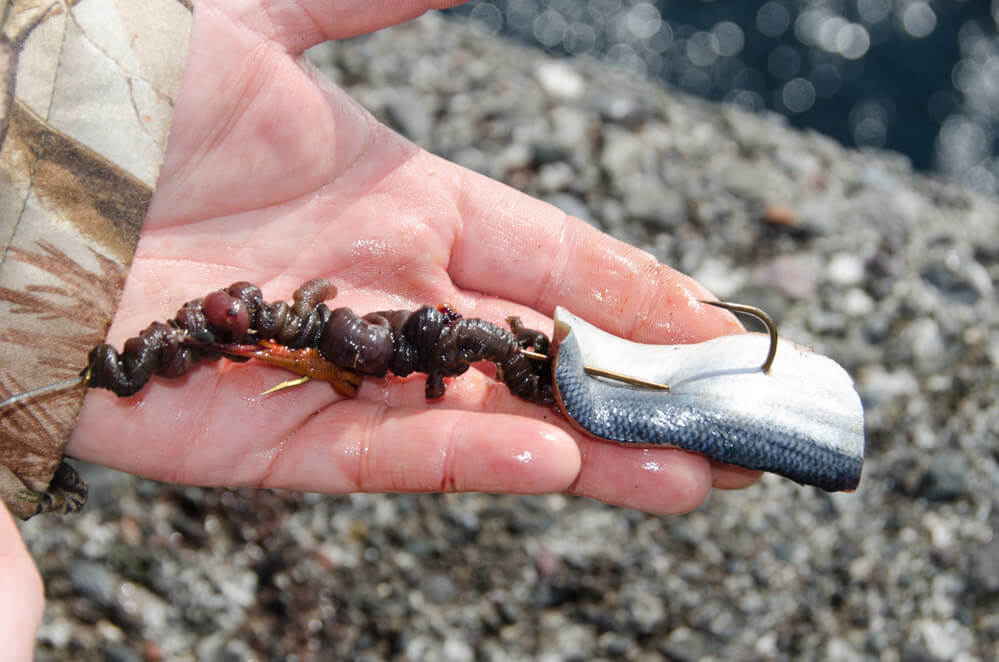
CLOTHING
Much depends on the direction of the wind. If it’s from the southern sector then it can feel quite warm and just normal trousers, T-shirt, shirt and sweatshirt will be enough, with a coat for the cooler evening. However also go prepared for a northerly wind, which even in high summer can cut through you. I wear normal trousers, T-shirt, shirt and hoodie, then top off with B&B trousers and a waterproof coat to stop the wind.
Hat wise I take a couple of baseball caps in case one blows off, plus a modern acrylic fleece hat.
Also take sunglasses, sun cream as you can still burn in colder temperatures, and some lip balm to stop chapped lips.
I tend to wear good quality climbing boots as these are warm having a big sole insulating you from the rocks and concrete, are waterproof, and give good grip on most surfaces, plus support the ankle properly when working on uneven surfaces.
THINGS YOU NEED TO KNOW
There are two guesthouses on Grimsey. Both offering a good breakfast, plus a warm and friendly atmosphere. I believe they also do an evening meal if requested.
There is a restaurant and bar, with reasonable meal prices for a burger and chips etc. Beer is more expensive than the UK, but not as bad as some people make it out to be. An option is to buy a slab or two of beer at duty free in Akureyri, or at the supermarket in Dalvik. We did both!
There is a store selling groceries if you want to make sandwiches, or pick up snacks and drinks during your stay.
GETTING THERE
Steve Mason can provide a full fishing package for anglers looking to fish Grimsey Island and frankly is the only way I’d go. You’re picked up at the airport, whisked away to your accommodation, the ferry is sorted for you, pretty much all you have to do is turn up and fish. Steve can also be your day to day guide as he’s fished all over Iceland having been a resident for the past 20-years or more. His knowledge of the whole country is amazing, plus coming from the Northeast of England and being an obsessive angler all his life gives him the ability to work easily with the people he’s guiding.
There are flights to Iceland from numerous airports in the UK. We flew from Manchester to Keflavik, then took an internal flight to Akureyri where Steve picked us up.
The ferry to Grimsey leaves from Dalvik and takes about three hours. You may see whales including leaping humpbacks, and these often come to the boat which will stop to allow you to take photographs. It’s an experience in itself! This ferry in summer goes Monday, Wednesday and Friday.
The island is also serviced by a small passenger flight schedule from Akureyri as an alternative.
CONTACT
Contact Steve at Icelandic Fishing Adventures on 00 354 6180694 or E-mail steveifa@hotmail.com. There’s also a new website coming shortly and we’ll post a link to this when available.
I’d been in Dalvik on the mainland a couple of years previously fishing with Steve Mason, owner of Iceland Fishing Adventures, and we’d pondered the possibility then of getting out to Grimsey, but time and work commitments meant we had to let the chance pass. The thought never left us and the intention was to get there as soon as possible.
It was two years later when Steve, Northeast angler Joe MacDonald, my fishing buddy Colin Albert from Cardiff and I boarded the Dalvik ferry to Grimsey with a car loaded down with gear with the intention of checking out the island over a short two day stay.
The island has sheer cliffs on the north side, but accessible rock ledges and boulder beaches on the south side. The ground is generally mixed rough and fine sand with kelp weed beds in close. To say it looks good for cod is very much an understatement!

We walked part of the coast in the north section and saw sandy ground with outcrops of kelp and rock pretty much as far as the eye could see in the gin clear water. Because of the water clarity we opted for a mark on the southern end close to an old wind turbine and found easy access on to a rock ledge in to moderately deep water, again with mixed clean and rough patches.
We had fresh lugworm dug on the mainland by Steve, fresh mussel, and the ever reliable bluey. We each chose our own combo and fired the baits out.

I could write this feature detailing our fish by fish catch, but it would be a feature of biblical proportions. No sooner had our baits hit the water, the rod tops were nodding. It was cod after cod ranging between 3 and maybe 8lbs. These were beautifully coloured rock cod, some orange, some a red or vermillion, others a golden brown to camouflage the cod in amongst the weed.

I was trying to keep pace with the camera as fish were being continually landed, at the same time conscious of my rod being dragged in to the sea by a hungry cod. This was on an ebbing tide and towards low water the bites eased, but did not disappear. But it was late afternoon and time to get something to eat. How many cod did we catch? I have no idea, we each had between 15 and 20 cod, so that’s around 75 cod for just four hours or so fishing.

The commercial harbour is flanked by a protective breakwater with casting access left and right of the marker post to a deeper ship channel. The depth here falls in to about 30-feet 40-yards out, but gets deeper if you put a long cast in. This was another mark we fished with the baits.
Nobody bothered to cast too far, 50-yard lobs were ample, just putting the bait in the middle of the channel. As before, as soon as the baits hit the bottom the rod tips were nodding to self-hooked cod. These were nice fish averaging 5lbs that just kept coming one after the other.

Coalfish were in amongst the cod. Colin and I were on the far end of the breakwater banging baits on to rougher ground. I was playing out a cod about 6lbs, when Colin briefly hooked a coalie before the hook pulled out. Suddenly, as the released bait fell in the water, the rod stopped dead and a heavy weight slammed the rod hard over. This fish just pressured the rod for the first few seconds confused as to what was happening, then bored off seaward, turned, ran in towards the breakwater and shot back out again dragging an alarming amount of line off the reel.
Having fished with Col for nigh on 30-years, I’ve seen him battle a good fish or two, and he’s not prone to surprise or panic, but I could see the shock in his face as to how hard this fish was pulling. He also felt the pressure of fishing for the camera and played the fish carefully. After a good 5-minute fight a silver blue shape materialised near the surface tight in to the jetty. We all saw the size of the beast, but little was said, it wasn’t caught yet. It made one more worrying crash dive for the seabed, but this sapped its energy and it was steered in to the waiting drop net. It weighed 18lbs and is indicative of what this unexplored area could produce once fully explored.

It was late evening now and the fishing just got better with bigger cod coming out to play. There were still the 5lbers, but mixed in evenly now with fish in the 7lb to 10lb range. Fat, healthy fish with a pop belly and weight behind their head, plus a broad paddled tail. Again, how many fish? Somewhere between 150 and 200 at a guess. How can you tell when its one after the other with no let up?
The lads went on to spinners and even float fished baits and still caught at the same rate. I went fly fishing and hooked a cod or a coalie each and every cast. The numbers of fish in front of us was nothing short of incredible.

We were due back on the ferry the next day, so had a short session on the breakwater to finish with exactly the same result, cod, cod, coalie, cod, cod, cod, coalie and so on.
Did we expect a few bigger fish? Yes, we did. But with hindsight, we fished it in August with little in the way of a dark night and with just the two days on the island a full night session was impossible. When, not if, I go back, then I’ll look to fish a dark tide and will expect to see bigger fish. I’d also consider going earlier or later in the year, say May/June or September when I think bigger fish may be more likely. This is just a personal opinion, but I’d like to try it!

TACKLE TO TAKE
The ground is not difficult to fish, also you don’t need to cast to range as it makes no difference to the catch rate. Steve provides top quality and powerful Century blanks which we used and are perfect for the job. However you take your own reels and I chose to fish a Penn 525Mag2 loaded with 22lb line. Apart from snagging up a few times when fishing the rock ledge towards low water by casting a long way, the 22lb line was more than enough. Take two reels, just in case you have a problem with the other, but it’s unlikely you’ll be fishing two rods as you just will not cope with the catch rate. There’s too many fish!
Steve also provides the lead weights and rod rests. All you need then is a box of general rig bits, spare shock leader, spare hooks, a honing stone, scissors, bait elastic and some pliers. Take a couple of spools of spare reel line too, in case of birdies or snap offs.
Regarding shock leader, due to the clarity of the water I would suggest only using clear mono. Yes the fish are fighting to get at your bait, but bigger fish are not so stupid and a clear mono makes logical sense, so why risk it?
RIGS
Both Colin and I built about 20 pulley rigs to take with us and brought most home. I made mine as follows and wouldn’t change the design…
- Begin with 46-inches of 80lb mono.
- At one end tie on a SALT Lead Link Clip.
- Slide on a 5mm bead, SALT pulley rig bead, and another 5mm bead.
- Leaving a good 20-inches of free line to form the hook length, tie in a figure of eight knot above the last bead.
- Slide on a Mustad 79510 pennel hook, then tie on a Mustad 79515 Uptide hook. Wrap the line around the hook shank of the top hook to secure in place.
- Normally I prefer my top pennel hook trapped inside electrical tubing, but when using 80lb mono I don’t worry as it is strong and not so prone to stretching when hooked in to a big fish. Plus it’s easy to adjust for differing bait sizes.
Although we had lugworm, also the odd clam with us, which all work well, the bulk of the fish came to bluey. I know it’s hard with a UK cod/lugworm mentality to think of cod taking fish baits, but you have trust these words, the Icelandic cod love bluey and it fishes better than worm in my experience.
I just stick to bluey baits, either using the cone section from the tail with the tail fin cut off, or a straight body section anything from 3-inches long to a full body with just the head and tail taken off. Alternatively a body section with one fillet removed to leak plenty of scent out.

CLOTHING
Much depends on the direction of the wind. If it’s from the southern sector then it can feel quite warm and just normal trousers, T-shirt, shirt and sweatshirt will be enough, with a coat for the cooler evening. However also go prepared for a northerly wind, which even in high summer can cut through you. I wear normal trousers, T-shirt, shirt and hoodie, then top off with B&B trousers and a waterproof coat to stop the wind.
Hat wise I take a couple of baseball caps in case one blows off, plus a modern acrylic fleece hat.
Also take sunglasses, sun cream as you can still burn in colder temperatures, and some lip balm to stop chapped lips.
I tend to wear good quality climbing boots as these are warm having a big sole insulating you from the rocks and concrete, are waterproof, and give good grip on most surfaces, plus support the ankle properly when working on uneven surfaces.
THINGS YOU NEED TO KNOW
There are two guesthouses on Grimsey. Both offering a good breakfast, plus a warm and friendly atmosphere. I believe they also do an evening meal if requested.
There is a restaurant and bar, with reasonable meal prices for a burger and chips etc. Beer is more expensive than the UK, but not as bad as some people make it out to be. An option is to buy a slab or two of beer at duty free in Akureyri, or at the supermarket in Dalvik. We did both!
There is a store selling groceries if you want to make sandwiches, or pick up snacks and drinks during your stay.
GETTING THERE
Steve Mason can provide a full fishing package for anglers looking to fish Grimsey Island and frankly is the only way I’d go. You’re picked up at the airport, whisked away to your accommodation, the ferry is sorted for you, pretty much all you have to do is turn up and fish. Steve can also be your day to day guide as he’s fished all over Iceland having been a resident for the past 20-years or more. His knowledge of the whole country is amazing, plus coming from the Northeast of England and being an obsessive angler all his life gives him the ability to work easily with the people he’s guiding.
There are flights to Iceland from numerous airports in the UK. We flew from Manchester to Keflavik, then took an internal flight to Akureyri where Steve picked us up.
The ferry to Grimsey leaves from Dalvik and takes about three hours. You may see whales including leaping humpbacks, and these often come to the boat which will stop to allow you to take photographs. It’s an experience in itself! This ferry in summer goes Monday, Wednesday and Friday.
The island is also serviced by a small passenger flight schedule from Akureyri as an alternative.
CONTACT
Contact Steve at Icelandic Fishing Adventures on 00 354 6180694 or E-mail steveifa@hotmail.com. There’s also a new website coming shortly and we’ll post a link to this when available.

